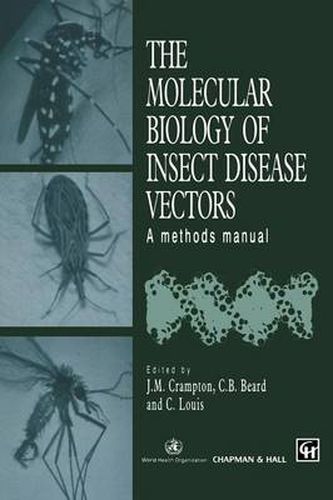Readings Newsletter
Become a Readings Member to make your shopping experience even easier.
Sign in or sign up for free!
You’re not far away from qualifying for FREE standard shipping within Australia
You’ve qualified for FREE standard shipping within Australia
The cart is loading…






This title is printed to order. This book may have been self-published. If so, we cannot guarantee the quality of the content. In the main most books will have gone through the editing process however some may not. We therefore suggest that you be aware of this before ordering this book. If in doubt check either the author or publisher’s details as we are unable to accept any returns unless they are faulty. Please contact us if you have any questions.
This handbook of laboratory methods covers all aspects of molecular entomology. The molecular sciences have great potential to further our understanding of insects, how they interact with the environment, and the pathogens they transmit. Advances in molecular biology may also provide novel strategies for controlling insect populations. In the case of disease-carrying insects, this may involve altering their ability to transmit pathogens to human or animal populations. The field of molecular entomology (as distinct from Drosophila molecular biology) was virtually non-existent. A major initiative from the World Health Organization (Special Programme for Research and Training in Tropical Diseases) has sought to rectify this, and this volume is a part of the particular methodology. Each chapter is written in such a way that a competent scientist who is unfamiliar with the method described can carry out the technique. Methods are described in a simple, yet detailed, step-by-step manner incorporating lists of materials and explanatory notes. This volume covers insect maintenance and infection through to basic molecular biology and specialized techniques in molecular entomology. As such, it is intended for entomologists wishing to apply molecular techniques to their own work, and also to molecular biologists who are moving into the field of insect disease vector biology. This book should be of interest to all level of academics in insect vector biology, molecular biology, vector ecology, parasitology, entomology. Also academics in agricultural entomology and academics in tropical countries or in tropical medicine departments.
$9.00 standard shipping within Australia
FREE standard shipping within Australia for orders over $100.00
Express & International shipping calculated at checkout
This title is printed to order. This book may have been self-published. If so, we cannot guarantee the quality of the content. In the main most books will have gone through the editing process however some may not. We therefore suggest that you be aware of this before ordering this book. If in doubt check either the author or publisher’s details as we are unable to accept any returns unless they are faulty. Please contact us if you have any questions.
This handbook of laboratory methods covers all aspects of molecular entomology. The molecular sciences have great potential to further our understanding of insects, how they interact with the environment, and the pathogens they transmit. Advances in molecular biology may also provide novel strategies for controlling insect populations. In the case of disease-carrying insects, this may involve altering their ability to transmit pathogens to human or animal populations. The field of molecular entomology (as distinct from Drosophila molecular biology) was virtually non-existent. A major initiative from the World Health Organization (Special Programme for Research and Training in Tropical Diseases) has sought to rectify this, and this volume is a part of the particular methodology. Each chapter is written in such a way that a competent scientist who is unfamiliar with the method described can carry out the technique. Methods are described in a simple, yet detailed, step-by-step manner incorporating lists of materials and explanatory notes. This volume covers insect maintenance and infection through to basic molecular biology and specialized techniques in molecular entomology. As such, it is intended for entomologists wishing to apply molecular techniques to their own work, and also to molecular biologists who are moving into the field of insect disease vector biology. This book should be of interest to all level of academics in insect vector biology, molecular biology, vector ecology, parasitology, entomology. Also academics in agricultural entomology and academics in tropical countries or in tropical medicine departments.